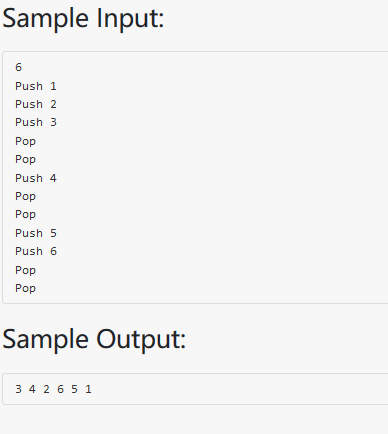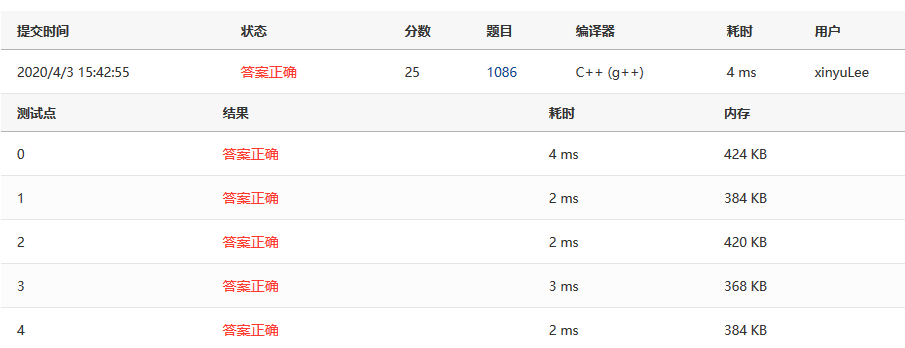An inorder binary tree traversal can be implemented in a non-recursive way with a stack. For example, suppose that when a 6-node binary tree (with the keys numbered from 1 to 6) is traversed, the stack operations are: push(1); push(2); push(3); pop(); pop(); push(4); pop(); pop(); push(5); push(6); pop(); pop(). Then a unique binary tree (shown in Figure 1) can be generated from this sequence of operations. Your task is to give the postorder traversal sequence of this tree.

Figure 1
Input Specification:
Each input file contains one test case. For each case, the first line contains a positive integer N (≤30) which is the total number of nodes in a tree (and hence the nodes are numbered from 1 to N). Then 2N lines follow, each describes a stack operation in the format: "Push X" where X is the index of the node being pushed onto the stack; or "Pop" meaning to pop one node from the stack.
Output Specification:
For each test case, print the postorder traversal sequence of the corresponding tree in one line. A solution is guaranteed to exist. All the numbers must be separated by exactly one space, and there must be no extra space at the end of the line.

#include <cstdio>
#include <cstring>
#include <stack>
//已知树的前序和中序,输出树的后序
using namespace std;
struct node{
int data;
node* lchild;
node* rchild;
};
int pre[35] , in[35] ;//先序,中序
int N;//节点个数
stack<int> nums;
//建树
node* creat(int preL, int preR, int inL, int inR)
{
if(preL > preR) return nullptr;
node* root = new node;
root->data = pre[preL];
int k;
for (k = inL; k <= inR; k++)
{
if(in[k] == pre[preL]) break;
}
int numLeft = k - inL;
root->lchild = creat(preL + 1, preL + numLeft,inL, k-1);
root->rchild = creat(preL + numLeft + 1, preR, k +1, inR);
return root;
}
//后序输出
int flag = 0;
void postorder(node* root)
{
if(root == nullptr) return;
postorder(root->lchild);
postorder(root->rchild);
printf("%d", root->data);
flag++;
if(flag < N)printf(" ");
}
int main()
{
char str[10];
int num, k = 0,n = 0;
scanf("%d", &N);
for (int i = 0; i<2*N; ++i)
{
scanf("%s",&str);
if(!strcmp(str, "Push"))
{
scanf("%d",&num);
nums.push(num);
pre[k] = num;
k++;
} else
{
in[n] = nums.top();
nums.pop();
n++;
}
}
node* root = creat(0, N-1, 0,N-1);
postorder(root);
return 0;
}
